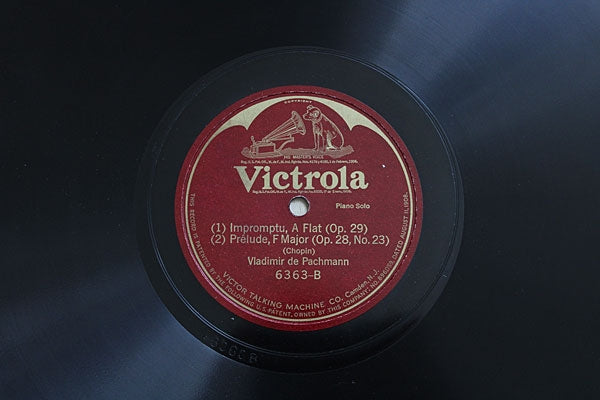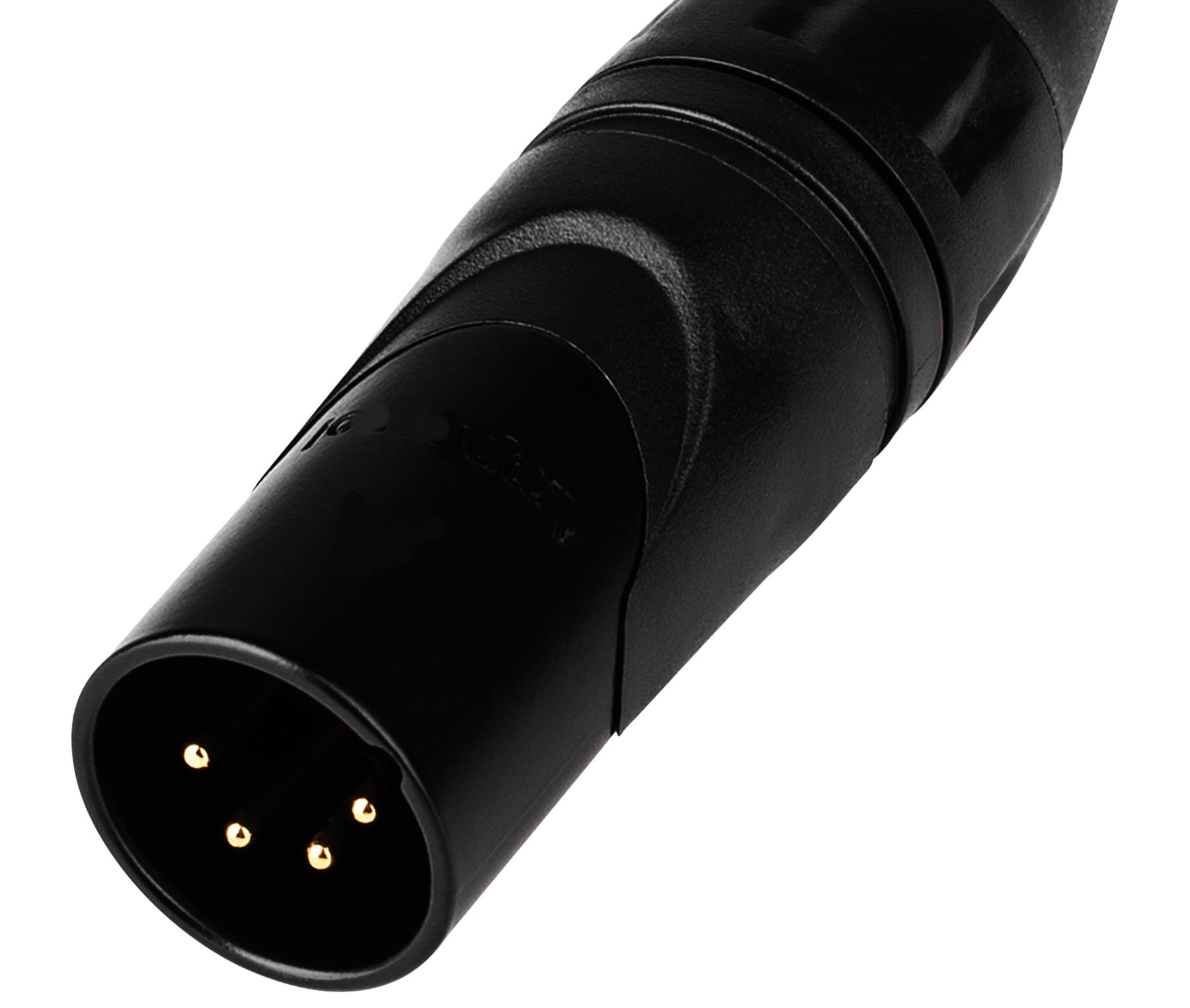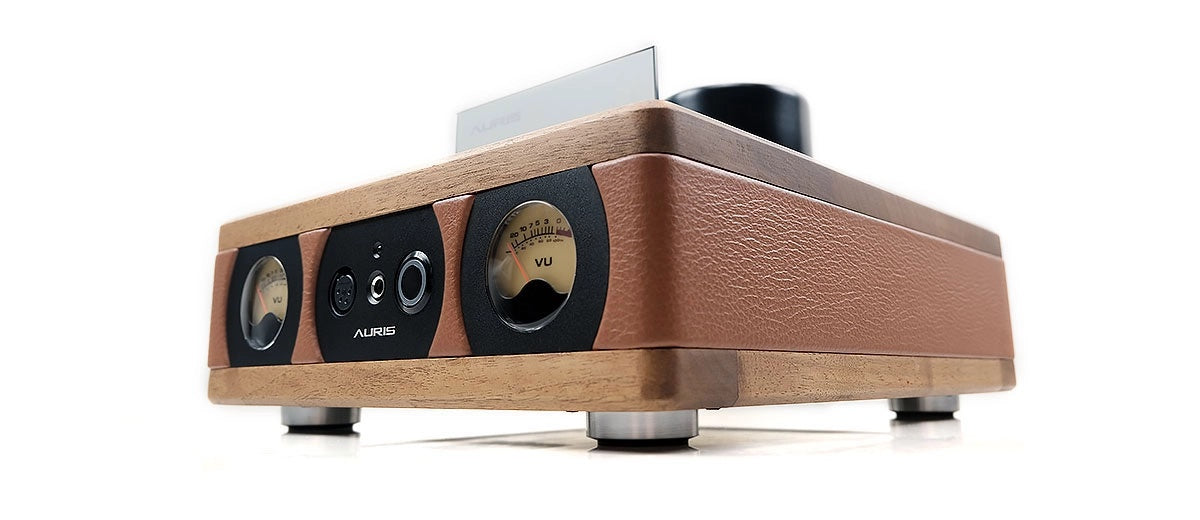 Gramophone Dreams #41: Auris Nirvana headphone amplifier & Focal Stellia Casque de Musique headphones
Gramophone Dreams #41: Auris Nirvana headphone amplifier & Focal Stellia Casque de Musique headphones
"Future generations will be able to condense into the brief space of twenty minutes the tone pictures of a lifetime—five minutes of childish prattle, five moments embalming the last feeble utterances from the death-bed. Will this not seem like holding veritable communion with immortality?"—Berliner Gramophone Company ca 1877
Patented by German-American inventor Emile Berliner in 1887, the Gramophone, which later became, generically, the small-g gramophone, is a device for making permanent, direct-to-flat-disc recordings (footnote 1)—of the human voice, musical instruments, or other sounds, and for playing back those stylus-inscribed discs, enjoyably, with sounds that resemble those of the original event.
Today, more than 120 years after that invention, people around the world still listen to voices and musical instruments reproduced via radially inscribed flat discs. The vividness of their effect still feels like a communion with immortals.
Most months, I begin my review explorations not by reading published specifications or absorbing manufacturer-website hyperbole but by using the component I'm auditioning to appreciate whatever music I am obsessing about at the time. This month, I was obsessed by the piano recordings of Vladimir de Pachmann, a pianist whose early–20th century performances of Chopin feel like a communion with impassioned Romantic-era pianism.

Inspired by a friend's Facebook post showing the red label of a Victrola 78rpm disc, from August 11, 1908, that featured de Pachmann playing Chopin Impromptu No.1 (Op.29) and Prélude No.23 (Op.28), I started listening to every de Pachmann recording I could track down. I got stuck on and began repeat-playing an audiophile-quality 1967 Everest LP that I found, long ago, in the back room at Academy Records here in New York City: Vladimir de Pachmann Plays Chopin (Everest LP X-921). This modern de Pachmann disc contains a September 9, 1923, performance of the Chopin Op.29 Impromptu and another of the Op.28 Preludes.
Born in Odessa, Ukraine, in 1848, de Pachmann died in 1933, so the majority of his performances were recorded acoustically to Berliner discs or on paper-roll transcriptions made on Welte-Mignon or Aeolian Duo-Art recording pianos. An Aeolian piano was used to record the performances featured on the Everest disc.
The Aeolian Company's Duo-Art piano recording system was introduced in 1913 to compete with the Welte-Mignon recording system, which had been introduced in 1905, and the American Piano Company's Stoddard-Ampico system, which was launched around 1911. Aeolian arrived late to the roll-recording scene, but immediately its Duo-Art System was regarded as the most advanced of the three systems, because it more accurately recorded and reproduced the speed, dynamics, pedal effects, methods of attack, shadings, and nuance of the original performance. During the 1920s, Steinway incorporated the Duo-Art System as an option on some of its pianos.
Everest Records used a restored 1929 Steinway/Duo-Art piano to recreate de Pachmann's ethereal pianissimo while capturing its sound with three calibrated AKG omnidirectional microphones feeding a Gauss Electrophysics "focused gap" recorder, allowing de Pachmann aficionados to experience the paper-roll master in audiophile-quality stereo. If this is not communing with immortals, what is?
The Auris Nirvana Headphone Amplifier
Because most headphones employ sensitive, full-range drivers with high, flat impedances, a dozen volts, less than half an amp, and only a few watts will power any of them to 100dB sound pressure levels, at low distortion. We can drive them with low-power, single-ended tube amps without fear of clipping or excessive second-harmonic sauce. An amplifier like the single-ended Auris Nirvana headphone amplifier/preamplifier (footnote 2), which is specified (with optional 12AX7 driver) to produce a maximum of 6Wpc into 32 ohms, might accidentally fall asleep while driving the 32 ohm, 106dB/mW, Focal Stellia closed-back headphones. The Stellia have replaced Focal's Clear as my new daily-driver reference headphones. For weeks, I've been using them to dream with Vladimir de Pachmann, Bob Marley, and Ennio Morricone.

I wish you could all experience how naturally toned, corporeal, and exquisitely animated this 1967 Everest recording of that 1923 de Pachmann performance sounds. With the Auris Nirvana amp and Focal Stellia headphones, Chopin's Op.28 Prelude seemed near-perfect, soundwise: clear, solid, three-dimensional, and engaging. The piano sounds I experienced with this combination felt like urgently coded messages, direct from Chopin and de Pachmann, speaking from another place and time.
What I am describing here is a haunting, solitary musical experience, one that would be easy to replicate in anybody's home at way less than CEO prices. The Focal Stellia headphones (described below) cost $2990, and the Auris Nirvana amplifier costs $5799. I know, I know, my Dr. Feickert Blackbird turntable with Jelco TK-850L arm and Grado Aeon3 cartridge is not free—it's about $17,000 including the Parasound JC 3+ phono stage—but the glories of its sound make it seem to me like a bargain to me.
With the Dr. Feickert record player spinning the Everest-Pachmann LP, the Auris tube amplifier drove the Focal Stellia closed-backs in a manner I would describe as straightforwardly neutral and well-controlled but also glowing and magical.
With the Abyss: Upping the ante—seeking an even higher high—I played that Chopin Prelude again, this time with the Auris amplifier powering my reference JPS Labs Abyss AB-1266 Phi TC headphones ($4995). All I achieved, compared to the Focal Stellia, was a more conspicuously open sound with a bit more solidity and a more scintillating transparency. With the 47 ohm, 88dB/mW Abyss Phi TC, the Nirvana amplifier displayed a dark, silent transparency and a restrained sense of force and density. I was in awe of how microscopically detailed the Aeon (Dr. Feickert)-Nirvana-Abyss partnering was.
The Auris Nirvana's home-decorator–attractive wood and metal chassis weighs 30lb (13.5kg) and measures 11.8" (300mm) × 15.4" (390mm) × 8.3" (210mm). The standard tube complement is one 12AU7/ECC82 dual-triode driver and two 6CA7/EL34 output tubes, one per channel. At top front are three knobs: The left-most selects headphone impedance (32 ohms, 80 ohms, 150 ohms, 300 ohms, and 600 ohms) via five separate taps on the secondary of the Nirvana's output transformer. The center knob is the volume control. The knob on the right selects among three back-panel line-level inputs, two single-ended (RCA) and one XLR. Also on the back panel is a cinch connector for attaching the main amp-circuitry chassis to a separate aluminum-cased 7.8lb (3kg) power supply via a 24" umbilical cord connecting. The power supply measures 5.7" (144mm) × 8" (204mm) × 3" (74mm). A remote control is optional.
The stock 12AU7 tube is a medium-mu (20) tube, but a high-mu (60) ECC81/12AT7 or an even higher-mu (100) ECC83/12AX7 tube may be substituted, allowing for increased gain, power, and voltage sensitivity. The Nirvana's input is rated at 1.4V for full output.
Via email, I asked Auris sales manager Miroslav Milovanovic how much power the Nirvana could deliver to each of its selectable headphone impedances. He replied, "With the stock ECC82 driver tube, at 1.4V in, it would generate 10V/3W into 32 ohms, 23V/3.5W into 150 ohms, and 42V/3.5W into 600 ohms."

Nirvana with Susvara: In Bed-Stuy Brooklyn, during the intense Black Lives Matter protests, there were helicopters and military-loud all-night-long barrages of "no justice, no sleep" fireworks. As my own form of sympathy, I played "Get Up, Stand Up" from the first reggae album I heard when I came to NYC, in 1974: Burnin' by the Wailers with Bob Marley (16/44.1 FLAC Tuff Gong/Qobuz). I listened with the 60 ohm, low-sensitivity (83dB/1mW), open-back, planar-magnetic HiFiMan Susvara headphones. Their $6000 price is Babylonian high (although 24kt gold is sputtered on the Susvara's nano-thin diaphragms). But! Driven by the Auris Nirvana amplifier, the sound, especially the bass guitar and Marley's distinctive voice, were tidepool-clear, Rastafari-strong, and natural of tone.
With the Susvara connected to the Nirvana's 80 ohm tap, I also listened to Tunisian composer and oud player Anouar Brahem's 2000 album Astrakan Café (24/44.1 FLAC ECM/Qobuz). Astrakan Café is a timeless-feeling sound collage that is dominated by the rhythms and harmonies of exotic instruments. The Susvara-Nirvana alliance kept the album's rhythms and nuance in the frontal lobe of my listening awareness. The Auris, Susvara, and Jan Erik Kongshaug's recording-mixing-mastering combined to let the instruments in Brahem's trio (the oud, darbouka, and clarinet) sound like they were being played in a great marble-floored hall. The zest and purity of the Nirvana-Susvara sound made Brahem's Astrakan Café into a memorable audio moment.
Woo WA5 comparison: The Woo Audio WA5 headphone amp/preamp is the best-sounding, most exciting headphone amplifier I have yet reviewed for Stereophile. Like the Auris, the Woo is a two-chassis tube amp. In its base configuration, it costs $5899—just $100 more than the Nirvana. Unlike the Auris, which appears to use solid-state rectifiers and regulators, the WA5 features a dual-mono, tube-rectified (274B × 2), choke-filtered power supply and an amplifier circuit with octal-based 6SN7 dual triodes driving single-ended, directly heated 300B tubes. My review sample of the Woo came with optional Takatsuki Denki 300B tubes ($1995/pair) and a $1250 premium parts upgrade for a price of $9144 as reviewed. The Woo is long gone, but I remember still, and will never forget, how the WA5 played all my headphones with a luminous, spatial fullness.
The Auris Nirvana is not as LSD-300B radiant, atmospheric, or dramatically three-dimensional as my memory of the WA5, but it is more solidly detailed and directly spoken.
I have auditioned a variety of single-ended EL34 power amplifiers. The Auris does not sound like any of them. The Nirvana shows more force and well-sortedness, which, I suspect, results from the character of its 7.8lb power supply. The Nirvana comes stock with new tubes, as it must: JJs and Russian-manufactured Mullards, which are quiet and good but not brilliant or exciting. A little bird tells me that the Nirvana might respond dramatically to rolling vintage tubes. Vintage European or American tubes would more than likely open up and lively up the Nirvana's slightly buttoned-down sound.
Compared to the ZMF Pendant: I have zero doubt that many headphone aficionados would prefer the bouncy, sunny-bright clarity of ZMF's $2500 Vérité closed-back headphones over the darker, more serious insightfulness of the $6000 HiFiMan Susvara or the recording-studio resolution of he $4995 Abyss AB-1266 Phi TC. And why shouldn't they? The reasonably priced, 300 ohm, 99dB/mW-sensitive Vérité make music sound engagingly lifelike. Right now, they are my favorite closed-backs because they minimize cupping effects, and their angular-mounted, beryllium-coated, polyethylene-naphthalate dynamic drivers deliver relaxed but controlled sound and image with better delineation than any closed circumaural headphone I know.
My initial impressions of the ZMF Vérité headphones (Gramophone Dreams, April 2020) were formed using the $1999–$2499 Justin Weber–designed ZMF Pendant amplifier, which made the Vérité sound superclear and intimately detailed while giving recordings an ear-pleasing burnished tone. To my taste, the Pendant was perfect with the Vérité. The Pendant is gone, but my memory of it is clear enough for me to state that the Nirvana and Pendant sound very similar driving the Vérité. If I had to separate these amplifiers, I would say the Pendant made music more easy-flowing and tube-magical while the Nirvana played with greater wallop. Take your pick; both amps reside at the top of Headphone Mountain.
Focal Stellia Casque de Musique headphones
I have the Focal Stellia (footnote 3) on my current shortlist of superfidelity 'phones because my auditions at CanJam NYC 2020 were extremely positive. At CanJam, it was obvious that Focal's 1.5" (40mm) M-shaped electrodynamic beryllium-dome drivers were delivering a very high level of relaxed and refined sound, with no beryllium metallic-ness. And, for reasons I cannot yet fully explain, I am feeling extra-good about closed-back headphones.

After my CanJam Stellia audition, I reviewed the ZMF Vérité and found it sonically reminiscent of the legendary Sony MDR-R10 closed-back, dynamic-driver headphone, which many regard as the sky god of all the headphones ever made. Noticing that similarity caused me to wonder: Is there something about closed-back headphones that makes them sound more lifelike than open-backs? I did not know, but ... I had a hunch that Focal's closed-back Stellia would help me answer the question. I also thought they would make an excellent tool for comparing the $2599 Feliks Audio Euforia Mark II amplifier I described in the December 2019 Gramophone Dreams to the Auris Nirvana described above.
That hunch was based on how delightfully and evocatively the Euforia powered my daily-driver Focal Clear headphones, which sounded extremely good but sometimes a tad dull powered by Mytek HiFi's Brooklyn DAC+ DAC/preamp/headphone amp. The Feliks Euforia makes only 0.13 watts into 32 ohms, 0.2 watts into 100 ohms, and 0.08 watts into 600 ohms. Voltage gain is 20dB, and output impedance 20 ohms.
"Do you remember all those psychedelic nights? When your head came loose and floated into the lights." That is country singer and fine artist Terry Allen singing "After the Fall" on one of my 2015 R2D4 albums, Human Remains (16/44.1 FLAC Sugar Hill/Qobuz). "And all them girls without any tops at all. Down in the dirt. After the fall." Ever since Scarlett Rivera and Rolling Thunder, I like songs with an amplified violin singing behind an electric guitar. Ever since Dylan, I like doom and ironic social critique. Since it came out, I have played this faux-country art song on a multitude of extremely expensive stereos, some costing more than $1 million. On the best, it exploded into the room with big energy and abundant Terry Allen attitude.
Playing "After the Fall" through the Nirvana and Focal Stellia, the song's doom entered my head with force, but it was 30% low on psychedelic color. My head did not float into the lights.
The less expensive, less powerful Feliks Euforia put more excitement and colorful energy into the Stellia. The Euforia displayed more of Terry Allen's Texas gusto and not-subtle sarcasm than did the Nirvana. Vocal tone was more complex and expressively nuanced. The Feliks put light and fire into Terry Allen's dark nights.
So why was the output-transformerless Euforia so effective with the 35 ohm, 106dB/mW Stellia? I don't rightly know. Other than the Stellia's high sensitivity, the Feliks amplifier's high (20 ohm) output impedance driving the Stellia's low (35 ohm) impedance might factor in—maybe in a positive way? What I do know is that the HoloAudio May DAC connected to the Feliks Audio Euforia powering Focal's Stellia closed-backs produced vital, exciting sound.
Atmosphere, soundstage dimensionality, and precise image mapping are elements I expect and cherish in floorstanding sound systems, but with headphones I expect and cherish the feeling of being in the space with the microphones and musicians. These are very different "Where am I?" experiences. In an attempt to mitigate this imaging disparity, both the ZMF Vérité and Focal Stellia angle their dynamic drivers (relative to the listener's ears) in a way that encourages the listener to "see" a bigger soundstage and more of the action as it happens in front of them.
I mention these headphone-imaging issues because at the start of my story I was obsessively reestablishing my communion with the immortal pianissimos of Vladimir de Pachmann, during which his piano appeared in front of me. Now, 30 days later, Italian composer Ennio Morricone has died, and my past life and artistic viewpoints are Rolodexing through my mind.
When I was a teen, Sergio Leone's Dollars Trilogy had an enormous impact on what I admired in cinema and music. To my young senses, these innovative films struck a perfect balance between unprecedented realism (for a Western) and unprecedented abstraction (for a film drama). These culture-shifting films came off as Homeric epic, aided by the force of Morricone's soundtracks, which allowed for long, mesmerizing scenes without dialogue.
Unfortunately, Morricone's scene-stealing music power did not fully survive the in-my-headness of the headphone experience. I still enjoyed my old favorite soundtrack, but compared to the theater it sounded emphysemic, like it does on all but the biggest sound systems. (Naturally, giant movie scores sound best on giant horn speakers.)
In order to enjoy The Good, the Bad and the Ugly (16/44.1 FLAC MGM/ Qobuz) with any headphones, I have to ignore my need for the sound action to be just as I remember it from the big sound systems of my past: large and completely in front of me. For this review, I forced myself to adapt by letting go of expectations while immersing my mind in the force of the soundtrack's sonic energy. Imaging was left-center-right. And of course, the Stellia's angled drivers played loud, clear, and dynamically. And yes, the sound seemed larger and more frontal when I closed my eyes.
When I finally stopped worrying about imaging, my mind floated back, easily and naturally, to the 1960s of my youth, when I discovered an evening of good, bad, and romance-filled memories.
In sum
For more than 120 years, people have made recordings to provide listeners with exciting, transcendent moments caused by the reproduction of sounds other people made in another place at another time. In the case of those Vladimir de Pachmann piano rolls, I felt I was communing with a long-forgotten art spirit. In the case of the Wailers' "Get Up, Stand Up" and Ennio Morricone's "The Good, the Bad and the Ugly," I was able to dream backward and reexperience some of the feelings that formed my present worldview. These were not trivial moments. These experiences are among the reasons I regard audio reproduction equipment, at the exalted performance levels of the Auris Nirvana amplifier and the Focal Stellia headphones, not as frivolous audiophile toys but as essential high-technology tools for self-discovery and a deeper appreciation of historic musical culture.





Leave a comment
This site is protected by hCaptcha and the hCaptcha Privacy Policy and Terms of Service apply.